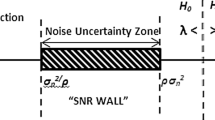Abstract
There is an enormous development of wireless communications in the past few years. Due to this frequency spectrum is becoming a very precious resource and insufficiency of the spectrum is a serious problem. So, there is a need to improve the utilization of spectrum effectively. Cognitive radio has demonstrated to be a successful innovation for catching the range, yet additionally for utilizing it. Spectrum sensing can be achieved utilizing a traditional energy identification method that utilizes a single threshold to identify the nearness or nonappearance of the signal, yet whose performance degrades when the SNR is low. To overcome this issue, researchers provide twofold threshold-based spectrum sensing, which looks at the history of sensing in the confusion zone. The test results are compared to these two levels, and a judgement is made on whether main users should be present. In simulations, the suggested double threshold approach outperforms both the double and single threshold detection methods. We investigated spectrum allocation and efficiency using the proposed double threshold method.





Similar content being viewed by others
References
Ate AAM, Mohamed S (2022) USRP implementation of spectrum sensing OFDM-based cognitive radio networks using energy ratio algorithm. FES J Eng Sci 11(1):1–6
Gao W et al (2022) Communication resources management based on spectrum sensing for vehicle platooning. IEEE Trans Intell Transp Syst
Gollamandala UB, Midasala V, Ratna VR (2022) FPGA implementation of hybrid recursive reversable box filter-based fast adaptive bilateral filter for image denoising. Microprocess Microsyst 90:104520
Ilgin FY (2022) Spectrum sensing with standart and demmel condition number under Gaussian approach. Telecommun Syst 79:1–8
Jiang W et al (2022) Multi-agent reinforcement learning for joint cooperative spectrum sensing and channel access in cognitive UAV networks. Sensors 22(4):1651
Kansal P et al (2022) An efficient composite two-tier threshold cooperative spectrum sensing technique for 5G systems. Arab J Sci Eng 47(3):2865–2879
Li X et al (2022) Connectivity probability analysis for green cooperative cognitive vehicular networks. IEEE Trans Green Commun Netw
Liang Z, Song C (2022) DNLS: a detection method based on normalized short-time fourier transform-radon transform for low frequency sonar pulse signal. IEEE Access 10:7025
Pittala CS, Vijay V, Naresh Kumar Reddy B (2022a) 1-Bit FinFET carry cells for low voltage high-speed digital signal processing applications. SILICON. https://doi.org/10.1007/s12633-022-02016-8
Pittala CS, Vallabhuni RR, Vijay V, Anam UR, Chaitanya K (2022b) Numerical analysis of various plasmonic MIM/MDM slot waveguide structures. Int J Syst Assur Eng Manag. https://doi.org/10.1007/s13198-022-01664-8
Priya JS, Padma T (2022) Adaptive channel allocation for spectrum sharing based on ACO algorithm. World Rev Sci Technol Sustain Dev 18(1):31–44
Rani BMS, Ratna VR, Srinivasan VP, Thenmalar S, Kanimozhi R (2021) Disease prediction based retinal segmentation using bi-directional ConvLSTMU-Net. J Ambient Intell Humaniz Comput. https://doi.org/10.1007/s12652-021-03017-y
Ridouani M et al (2022) A novel secure cooperative cognitive radio network based on Chebyshev map. Digital Signal Process 126:103482
Sheng J et al (2022) TCVQ-SVM algorithm for narrowband spectrum sensing. Phys Commun 50:101502
Swathi S, Sushma S, Devi Supraja C, Bindusree V, Babitha L, Vallabhuni V (2022) A hierarchical image matting model for blood vessel segmentation in retinal images. Int J Syst Assur Eng Manag 13(3):1093–1101
Valadão MDM et al (2022) Cooperative spectrum sensing system using residual convolutional neural network. In: 2022 IEEE international conference on consumer electronics (ICCE), IEEE, pp 1–5
Vijay V, Reddy CV, Pittala CS, Vallabhuni RR, Saritha M, Lavanya M, Venkateswarlu S, Sreevani M (2021) ECG performance validation using operational transconductance amplifier with bias current. Int J Syst Assur Eng Manag 12(6):1173–1179
Yuhuai P, Xiaojing X, Ali KB, Xiaogang Z, Yasser DA-O, Usman T, Keping Y (2022) Securing radio resources allocation with deep reinforcement learning for IoE services in next-generation wireless networks. IEEE Trans Netw Sci Eng
Zhao Y et al (2022) A cooperative wideband spectrum sensing framework in the frequency domain for resource allocation with 5G-NR. Measurement 191:110756
Funding
The authors declare that they have no funding source for doing this research work.
Author information
Authors and Affiliations
Corresponding author
Ethics declarations
Conflict of interest
All authors declare that they have no conflict of interest.
Additional information
Publisher's Note
Springer Nature remains neutral with regard to jurisdictional claims in published maps and institutional affiliations.
Rights and permissions
Springer Nature or its licensor holds exclusive rights to this article under a publishing agreement with the author(s) or other rightsholder(s); author self-archiving of the accepted manuscript version of this article is solely governed by the terms of such publishing agreement and applicable law.
About this article
Cite this article
Chaitanya, K., Khadir, M., Sushma, S. et al. Double-threshold energy detection: noisy environment applied cognitive radio. Int J Syst Assur Eng Manag 13, 2944–2948 (2022). https://doi.org/10.1007/s13198-022-01764-5
Received:
Revised:
Accepted:
Published:
Issue Date:
DOI: https://doi.org/10.1007/s13198-022-01764-5




